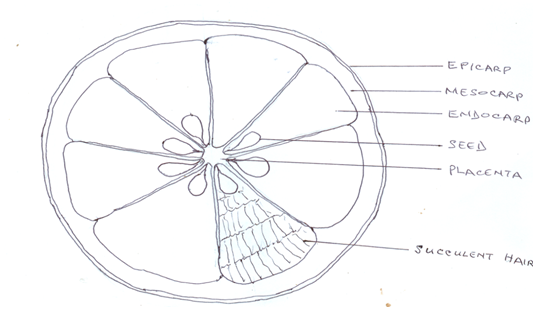Question 4
Study specimens T, V and W carefully and use them to answer questions 4(a) to 4(d).
(a) Classify specimens T, V and Waccording to the following criteria:
(i) agricultural classification;
(ii) life cycle. [6 marks]
(b) State two ways in which specimen W is important to human nutrition. [2 marks]
(c) With a scalpel or knife, make a cross section of specimen T.
(i) What type of placentation is observed in the cut section of specimen T? [1 mark]
(ii) Name one example of a fruit with similar placentation as observed in the cut section of specimen T. [1 mark]
(iii) Make a drawing 10 cm – 12 cm long of the transverse section and label fully. [10 marks]
(d) Make a transverse section of specimen V and state:
(i) three observable differences;
(ii) three observable similarities between the transverse sections of specimens T and V. [6 marks]
Study specimens Xi and Xii carefully and use them to answer questions
4(e) (i) to 4(e) (iii).
(e) Carefully remove the bark of specimen Xi to expose the naked part.
(i) State two observable differences between specimens Xi and Xii. [2 marks]
(ii) If Xi and Xii are planted, what difference will be noticed after a month? [1 mark]
Observation
Majority of the candidates did so well in answering questions 4 (a) (i), (a) (ii) and (c) (i) but lost some marks to spelling mistakes.
Many candidates answered questions (b) and (c) (ii) properly.
The drawing of transverse section of specimen T was answered quite well by some candidates but most lost marks to avoidable mistakes like in the title of the drawing and labeling properly.
Questions (d) (i), (d) (ii), (e) (i), (e) (ii) and (e) (iii) were answered correctly by many candidates
The expected answers are:
4 (a) Classification of specimens T, V and W according to
- Agricultural method
T- Fruit crop
V- Vegetable crop
W- Root tuber
- Life cycle
T- Perennial
V- Annual
W-Biennial
(b) Ways Specimen W is important to human nutrition
- Source of food/starch/carbohydrate;
- Energy is produced;
- Used for industrial purpose/employment/source of income.
(c) (i) Type of placentation
Axile
(ii) Example of a fruit with similar placentation
Garden egg; pepper; tomato or any other correctly named fruit.
TL- Title

Quality
NL- Neat Labels
CL- Clarity of Lines
Sz- Size (10-12cm)
Mg- Magnification (x½ – x2)
Details
CS- Cut surface with double lines
PS- Placenta shown
JS- Juice sac/succulent hair shown
Labels
Epicarp; mesocarp; endocarp; placenta; seed
(d) (i) Observable differences between the cross section of specimens T/Orange and V/tomato
Specimen T/Orange/Orange/Lemon/Lime/Citrus fruit |
Specimen V/Tomato |
|
Many seeds present; |
|
Smaller seeds present; |
|
Epicarp/ mesocarp are soft/juicy; |
|
Epicarp/ mesocarp is bright red; |
|
Big/large placenta; |
|
Juicy pulp/endocarp. |
(ii) Observable similarities between the cross section of specimens
T/Orange/Lemon/Lime/Citrus fruit and V/tomato
(e) (i) Observable differences between Specimens Xi and Xii
Xi |
Xii |
|
Node present |
|
Internode present |
|
Scale leaf/bark present |
|
Brown/Green stem |
(ii) Difference to be noted
Xii will germinate while Xi will not germinate/will decay
(iii) Reason
Xii possesses axillary buds that will make it germinate but they were removed in Xi
